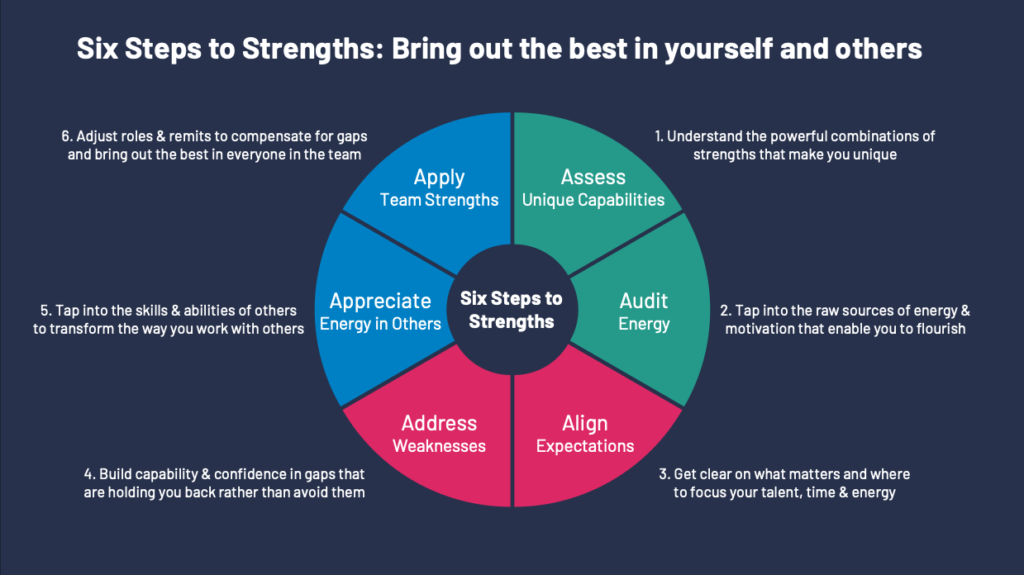Using your strengths as a leader is one of the best ways to bring out the best in others: and bring out the best in yourself. Yet in can be difficult to know where to start and what steps to take to apply your leadership strengths. This article sets out six key steps to becoming a strengths based leader.
The Strengths Based Leader
Being a leader brings great responsibility. In our decades of work developing leaders, we see a common response to that responsibility: leaders strive to be good at everything. Research, and our experience, tells us that the ‘well rounded’ leader is a myth. In fact, evidence shows great leaders have a strong understanding of their own unique strengths and can capitalise on them. So how do you do that?
Introducing the Six Steps to Strengths

© My Leadership Strengths
Assess Capabilities: Understand the powerful combinations of strengths that make you unique
Start by getting insight into capabilities and characteristics where you really excel. Using a strengths assessment tool will provide you with a shortlist of strengths. Review your report and try picking out promising strengths, as well as ruling out some others (and identifying critical weaknesses). It’s not about listing individual strengths, it’s about understanding the powerful combinations of strengths that make you unique.
Read our article on the Top 5 Strengths Assessment Tools to find out more about assessing your strengths
Audit Energy: Tap into the raw sources of energy & motivation that enable you to flourish
A strength is not simply something you are good at. A strength is something you excel at AND are energised by. You need to tap into the deepest resources of energy, which are raw, individual sources of strengths. Using your strengths supports you to flourish and has been shown to enable people to achieve a state of flow. So, using a strengths tool will give you insights and clues to your energisers.
However, you need to think like a scientist and experiment by measuring and adjusting your own formula for energy. This might include your Why (purpose & motivation), What (tasks & activities you love!), When (routines and times of day that work brilliantly for you), Who (people who drain you and those that radiate energy) and How (your distinctive style & method of leading others). Complete an energy log to spot patterns and describe when you are at your best.
Align Expectations: Get clear on what matters and where to focus your talent, time & energy
Get on the same page with your boss, your business partner, your team or your customer. Strengths need to be in service of something – they are powerful tools best employed to accomplish the most demanding jobs. Misalignment inevitably leads to problems including wasted effort; disappointment and discouragement; arguments and misunderstandings; or conflict. So, if you are not playing to your strengths you might need to reassess your goals, job or even your career.
The best way to get aligned on expectations is through dialogue about what good looks like: goals & outputs, tasks & activities, behaviours & attitude. Write them down. Use job crafting techniques to tailor your job. Personalise what you do and how you spend your time around your unique strengths.
Address Weaknesses: Build capability & confidence in gaps that are holding you back
A common misconception about strengths is that you can simply ignore your weaknesses. You can’t. You really need to recognise your own short comings and the impact of your weaknesses on others. This is especially crucial for a leader. Weaknesses won’t fix themselves, especially when they are avoided or covered up. So don’t be ‘all hat, no trousers’: strengths work best when they are built on solid foundations. However, prioritise the weaknesses you need to work on: some gaps can be best filled by tapping into the strengths of others (see ‘Apply Team Strengths’ below).
To address your weaknesses, you need to get honest, critical feedback. Invest time and effort working on key skills that undermine your performance or will hold you back from future opportunities. Address them through deliberate practice and feedback from others.
Get detailed insights and feedback comments from your manager or a team member using the QPT+1 Report from My Leadership Strengths
Appreciate Energy in Others: Tap into the skills & abilities of others to transform the way you work with others
Spot energy in others through observation and reflection. Often the things others value and appreciate most about someone are not truly recognised by the person themselves. Firstly, discuss and explore what it takes to go from minor to major key. Secondly, look back to early life and non work interests or hobbies. Importantly, this is not about transactional task swapping, it is about deepening relationships with others that can transform the way you collaborate. Try partnering with someone to explore strengths and energy together.
Apply Team Strengths: Adjust roles to compensate for gaps and bring out the best in everyone in the team
Leadership is relational not transactional. Put strengths based team working into practice by understanding and appreciating the unique strengths of others. Most importantly, recognise where others compliment your strengths (not compete with them) so you can tap into the capabilities you need, when you need them. Don’t drain your own energy by keeping your engine running all the time(!).
Try tailoring roles and accountabilities across the team to maximise energy, mitigate individual weaknesses and get the very best from each other (collective job crafting). Crucially, delegate work that doesn’t play to your strengths, but does play to the strengths of the person you are delegating to. Create a psychologically safe team environment where people can be open about weaknesses, get feedback and learn from each other.

